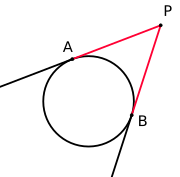Pitot theorem
In geometry, the Pitot theorem, named after the French engineer Henri Pitot, states that in a tangential quadrilateral (i.e. one in which a circle can be inscribed) the two sums of lengths of opposite sides are the same. Both sums of lengths equal the semiperimeter of the quadrilateral.


The theorem is a logical consequence of the fact that two tangent line segments from a point outside the circle to the circle have equal lengths. There are four equal pairs of tangent segments, and both sums of two sides can be decomposed into sums of these four tangent segment lengths. The converse implication is also true: a circle can be inscribed into every convex quadrilateral in which the lengths of opposite sides sum to the same value.
Henri Pitot proved his theorem in 1725, whereas the converse was proved by the Swiss mathematician Jakob Steiner in 1846.
References
- Josefson, Martin (2011), "More characterizations of tangential quadrilaterals" (PDF), Forum Geometricorum, 11: 65–82, MR 2877281. See in particular pp. 65–66.